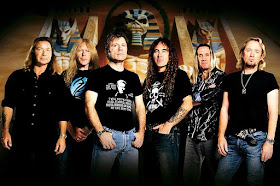We all know that recently some bands have been inducted into the "hallowed" halls of the Rock & Roll Hall of Fame in Cleveland. A lot of people are upset at some of the choices. Noticeably, there are no metal bands that have been inducted. When I saw some of the choices, my only thought is "WTF?" I definitely agree with Todd Rundgren, Tina Turner, Randy Rhoads and that band from Germany some consider strange called Kraftwerk. But LL Cool J and Jay-Z? Really? According to the good people at Ultimate Classic Rock, they've compiled a list of 10 bands that SHOULD be in these halls instead of rap and the other music there. Also, a lot of people think this should be called simply the Music Hall of Fame because of the menagerie of non-rock/metal artists inside.
Besides Deep Purple and Led Zeppelin, who already were inducted, metal seems to be the black sheep of the family in these halls. Out of the 40 years this hall has been up and running, only two metal bands have been inducted: Black Sabbath and Metallica. New Wave of British Heavy Metal legends Iron Maiden and speed metal legends Judas Priest have been nominated, but not inducted. And in years past, other thrash bands like Slayer and Megadeth don't even get a breath. While Motley Crue insists they've been blackballed from this institution.
Plenty of the metal bands out there are understandably frustrated at the hall including up and coming pop/hip hop artists. They are worthy, somewhat, but these metal bands think these artists should have come AFTER metal music, since metal was around before hip hop, which seems to be laced with stereotypes and slurs, depending on the artist.
According to the good people at Ultimate Classic Rock, here are 10 bands they believe NEED to be inducted into this hall
Iron Maiden
-No one does "do it yourself" metal better than Iron Maiden. This gang of East Enders was doing what no other band was doing at the time of their creation. And that is, instead of taking the money they've earned and blowing it on things they don't need, they took any money they earned and put it back towards the band for even bigger shows next time. Their manager, Rod Smallwood, even earned the nickname Rod Smallwallet because he wouldn't let the band spend ANY money unless it was to further progress the band. They've also worked their hands to the bone to make sure this band was known for producing good quality metal and not chasing trends. This band has inspired countless metal legends, with it's signature galloping bass, screaming lead dual guitars and soaring vocals that take you to the highest highs. Meanwhile, 40 years later, this band shows no signs of slowing down. If anything, they are picking up pace. The only time they've slowed down, in fact, is in 2016, when vocalist Bruce Dickinson came down with throat cancer.
Judas Priest
-The studded leather biker look has inspired many bands in the 80s glam era. Even for a time, Iron Maiden had adopted the leather and studs look, which, not shockingly, upset Priest. Their unique look is only one part of the equation. Toss in music ranging from doom-laden tracks of the 1970s to hard as steel rockers in the 1980s. Their 1980 album British Steel is said to be a defining record, inspiring hard rockers everywhere. More than 50 years later, vocalist Rob Halford can still scream and sing "Metal God", putting singers half his age, unfortunately even Bruce Dickinson of Iron Maiden, to shame
Ozzy Osbourne
-His solo stuff from the 1980s did for rock then what Black Sabbath did for rock in the 1970s. He brought in a new type of rock, with axe slinger Randy Rhoads, together this band brought in upbeat, yet still slightly sinister rock that seemed perfect for the 1980s. Osbourne seems to have unnatural talent at picking guitarists. Zakk Wylde, Jake E. Lee, Randy Rhoads are just some of the names he used the axe slinging talents of over the years and these names went on to form bands of their own. The hall did do one thing right-they inducted Rhoads in 2021, posthumously.
Dio
-You almost can't say the word "metal" without thinking of Ronnie James Dio. It's almost a crime in metal fans' minds that this vocalist wasn't inducted. He helped rescue Black Sabbath in the 1980s from complete failure with The Mob Rules and Heaven & Hell. He helped get Rainbow successful with Ritchie Blackmore's Rainbow, Rising, Long Live Rock 'n' Roll. He even formed his own self-named band and had successful hit after successful hit, like "Rainbow in the Dark", "Stand Up and Shout" and more. These are three reasons right here why this soaring vocalled, if short in stature singer needs to be inducted!
Motley Crue
-Unlike most of the 80s hair metal bands, Motley Crue survived. They outgrew the makeup and spandex, but they still dish out dirty, ratty metal about anything they like. They weathered the hurricane called grunge in the 1990s and came in to the 2000s shouting for the devil. They even managed to gain a new fanbase thanks to the Netflix adaptation of their memoir The Dirt. As time went on, their tours got more complex and insane, thus making the fans happy, which is what some bands want, right? The longevity this band has should earn them a place in this "hallowed hall"
Motorhead
-When it comes to Motorhead, a few things come to mind: outlaw attitude, loud music, gruff vocals. That and so much more all but perfectly describe this band of legendary metallers. Why Motorhead is NOT already in this hall is anyone's guess. This three man band revolutionized British metal, with frontman/bassist Ian Fraser Kilmister aka "Lemmy" up front, singing with vocals that make it hard to understand but give them a unique sound, thunderous drums from "Philthy" Phil Taylor and breakneck fast riffs from "Fast" Eddie Clarke. This band inspired dozens of bands, with songs like "Ace of Spades", "Overkill", which inspired thrash metal bands and even speed metal bands like Metallica, Napalm Death, Venom. Despite being called metal legends, Lemmy made it clear that he doesn't identify with metal. He declares at every show "We are Motorhead and we play rock 'n' roll"
Slayer
-Part of the "Big 4", they are said to have invented the subgenre extreme metal. They added aggression to their music, making them harder, faster, more aggressive than the other Big 4 bands. More than 35 years after its release, 1986's Reign in Blood remains their classic trademark album, raising the bar even higher on metal music. Even to this day, they are one of the best yet biggest extreme metal acts of all time. Fans love hearing the breakneck fast guitars, thundering drums, graphic imagery that comes with equally graphic lyrics.
Megadeth
-Metallica brought thrash metal to people's attention in 1991 with the release of the Black Album. Megadeth beat Metallica to it first by releasing 1990's Rust in Peace. There's always been a slight level of competition between Metallica and Megadeth. Front man Dave Mustaine had more to offer in Megadeth than Metallica. He and his bandmates out Metallica'd Metallica. He made sure he and his bandmates offered grittier, more thrash metal than his former bandmates. While Megadeth would never get the massive critical success of Metallica, their contributions to metal none the less are still important. They deserve induction. They match all the qualifications, one of which includes being around at least 25 years.
Pantera
-This metal band thankfully managed to survive the storm that was 90s grunge. They came out unscathed and are still making metal to this day. Their 1990 album, Cowboys from Hell pushed groove-metal into people's awareness and showed them that metal can have a groove to it. 1994 seen the release of Far Beyond Driven introducing extreme metal and going to #1 on the Billboard 200. The whole band together is successful in each of their own ways. Vocalist Phil Anselmo screams venomous lyrics that seem to almost relate to or soothe teens, guitarist "Dimebag" Darrell Abbott plays with such speed it's mind blowing. This makes him almost as successful as Eddie Van Halen. It's obvious this band deserves induction!
Scorpions
-This band was already on the path to success with their 80s albums Blackout and Love at First Sting. Between vocalist Klaus Meine's sometimes raspy, sometimes operatic vocals and twin lead guitarists Matthias Jabs and Rudolph Schenker, it's only natural that "No One Like You", "Rock You Like a Hurricane" have become successful hits. They inspired Metallica, Motley Crue and more, and yet, for them NOT to be inducted is a crime of the highest order in the minds of their fans








































































